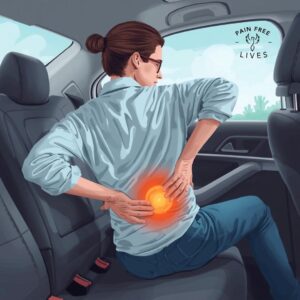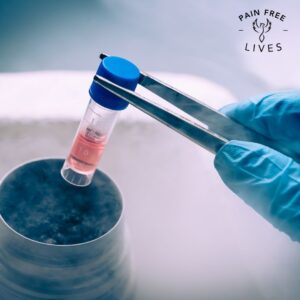For years, opioids have been the go-to solution for managing chronic pain. They offer quick relief and, for some, a lifeline in moments of unbearable discomfort. But over time, what begins as a medical treatment can turn into a dependency that overshadows quality of life. The opioid crisis has shown us the dangers of leaning too heavily on these medications. Now, regenerative medicine is opening a new door, one that focuses not on masking pain, but on healing the body at its core.
The Problem with Opioid Dependency
Opioids work by dulling the brain’s perception of pain. In the short term, this can be life-changing for patients with acute injuries, post-surgical discomfort, or severe illness. But for chronic pain conditions like arthritis, back pain, or degenerative joint disease, opioids aren’t a true solution.
Over time, the body builds tolerance, meaning patients need higher doses to achieve the same effect. Dependency can develop, leading to a cycle of physical reliance and emotional strain. Worse, opioids don’t actually repair damaged tissue or reverse disease they simply quiet the signal. Once the medication wears off, the pain often returns, sometimes stronger than before.
Why We Need Alternatives
The limitations of opioids highlight the need for pain treatments that go beyond symptom control. Patients deserve therapies that not only ease pain but also restore function, rebuild tissue, and improve long-term outcomes. This is where regenerative medicine comes into play. By leveraging the body’s natural healing processes, regenerative therapies aim to treat the root cause of pain rather than silencing it temporarily.
What Is Regenerative Medicine?
Regenerative medicine is an innovative branch of healthcare that focuses on repairing or regenerating damaged tissues. Instead of relying on external substances to mask pain, these treatments use the body’s own cells, proteins, and healing factors.
Common approaches include:
- Platelet-Rich Plasma (PRP): Concentrated platelets from a patient’s blood, rich in growth factors that promote tissue repair.
- Bone Marrow Aspirate Concentrate (BMAC): Stem cells and healing proteins taken from bone marrow to stimulate regeneration in joints, ligaments, and discs.
- Exosome therapy and other emerging techniques: Advanced biological tools designed to enhance communication between cells and accelerate healing.
Each of these therapies is minimally invasive, uses the patient’s own biology, and focuses on long-term repair rather than short-term relief.
How Regenerative Medicine Helps Break the Cycle
Unlike opioids, which can create dependency, regenerative treatments aim to reduce the need for medication altogether. By addressing the underlying damage, these therapies help decrease pain signals naturally. For example:
- A patient with knee osteoarthritis may experience reduced joint inflammation and improved cartilage function after PRP or BMAC, leading to less pain and greater mobility.
- Someone with chronic back pain from disc degeneration may benefit from regenerative injections that support tissue repair, reducing reliance on daily pills.
- Athletes recovering from tendon or ligament injuries often find regenerative medicine speeds healing, allowing them to return to activity without long-term medication use.
The Emotional and Social Impact
Breaking free from opioid dependency isn’t just about physical relief it’s about restoring independence and peace of mind. Patients caught in the cycle of dependency often report feelings of helplessness, anxiety, and frustration. Regenerative medicine offers hope by shifting the focus from temporary suppression to sustainable healing.
This also has broader implications for families and communities. The opioid epidemic has left lasting scars across society. By promoting alternatives that reduce dependency, regenerative medicine can play a role in building healthier, more resilient communities.
The Limitations and What to Expect
While regenerative medicine is promising, it isn’t a magic cure. Results can vary depending on age, health, and severity of damage. Some patients experience dramatic improvements, while others see gradual or moderate changes. Research is ongoing, and while evidence continues to grow, regenerative therapies are not yet universally covered by insurance.
That said, many patients see them as an investment in long-term health. Unlike opioids, which require constant prescriptions, regenerative treatments often involve a small number of procedures with lasting results.
A Shift in Pain Care
The movement away from opioids and toward regenerative medicine represents a larger shift in how we think about healthcare. Instead of simply managing pain, the future lies in restoring health. As research advances and therapies become more accessible, regenerative medicine has the potential to transform pain care from a cycle of dependency into a journey of healing.
Healing, Not Just Masking
Opioids may dull pain, but they don’t heal. Regenerative medicine takes a different path, harnessing the body’s natural power to rebuild and restore. For patients who feel trapped by dependency, it offers not just relief, but freedom: the ability to move, live, and thrive without relying on medications.
At Pain Free Lives, we believe pain care should go beyond short-term fixes. Through regenerative treatments, patient-centered guidance, and a commitment to long-term wellness, we help people find alternatives that truly change the story. From opioids to innovation, the future of pain relief is about healing from within.
For those seeking drug-free ways to manage pain at home, practical tools can complement advanced medical treatments. Infrared heating pads, supportive mattresses, and ergonomic sleep aids amazon.com/shop/painfreelives offer non-invasive relief that aligns with a regenerative, opioid-free approach to healing. These products provide comfort while supporting a healthier, long-term solution.







